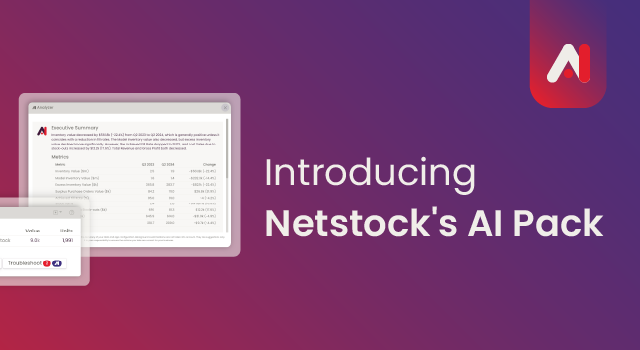What’s in this blog?
Imagine using a seamlessly automated inventory management system that not only enables you to meet customer demands but also effortlessly reduces carrying costs and enhances efficiency in inventory management!
Depending solely on manual methods such as spreadsheets or periodic stock checks often leads to errors, surprises, and headaches. What you truly need is an automated inventory management system to gain unparalleled real-time visibility into your inventory.
In this post, you’ll learn more about automated inventory systems, how they work, and what benefits they can offer your business to take your operations to the next level.
Introduction to automated inventory management
Automated inventory management utilizes software systems to handle tasks such as managing inventory levels, monitoring stock movements, generating purchase orders, managing sales data, and providing real-time updates on inventory status. This approach helps businesses streamline their inventory processes, reduce human error, improve efficiency, and ensure better management over their stock levels. It gives business owners an edge by freeing up time to focus on high-priority tasks and make data-driven decisions.
While today’s automated inventory management solutions feature AI, machine learning, and sales/warehouse integration, the evolution from manual processes dates back to the 1970s with barcodes. Later in the ‘80s/’90s, enterprise resource planning (ERP) systems and forecasting tools came into play. These tools helped businesses take a more proactive approach to inventory management.
Today, the inventory management software market is set to hit $7,516.8 million by 2034, with over $13.1% annual growth. This number demonstrates automated inventory management software’s growing importance and acceptance across sectors.
How it works
Let’s say you run a retail grocery store with an extensive product range. You want to manage your inventory to maintain ideal stock levels, avoid stock-outs, and increase customer satisfaction.
Here’s how an automated inventory management system works to help you achieve your goals:
- It records inventory received and sold using barcodes and RFID (radio-frequency identification) tags. When new stock arrives, you scan it, and it’s logged into the system.
- As you scan customer orders at checkout, the system automatically deducts products sold from available counts via integration with your point-of-sale (POS) software.
- The system integrates with order management, Enterprise Resource Planning (ERP), demand forecasting, and supplier management. This seamless data flow generates robust reporting on insights like stock velocities, forecasted demand, and supplier performance metrics.
- You can set up low-stock alerts and reorder notifications to proactively manage inventory replenishment before stock-outs occur. That way, you improve order fulfillment rates.
Benefits of inventory management automation
Automating your inventory management process can provide your business with three key benefits:
1. Enhanced accuracy and efficiency
Manual inventory management is time-consuming and error-prone. It often leads to stock-outs or overstocking, which no business wants. Automating tasks such as updating stock levels and generating purchase orders minimizes data entry errors and saves time and resources. Automated inventory solutions not only streamline operations but also offer valuable insights into historical data and trends, enabling accurate demand forecasting. This proactive approach keeps your business ahead of the curve by ensuring timely stock replenishment.
2. Real-time inventory visibility
Customers want to know that they can always count on your business to have products available. But how can you keep up if you don’t even know your stock levels? This is where an automated inventory management system can help. It provides up-to-date insights into stock levels and movement so you can make informed decisions and ensure you have the right products in the right place at the right time. With an automated system, you can focus on delivering exceptional customer experiences every time.
3. Cost reduction and scalability
When you manage your inventory manually, you need people to handle tasks such as updating spreadsheets, which can be costly as your business grows. Automation streamlines your inventory management process, reducing the need for manual labor to run your operation. Plus, it also allows your team to focus on more important work that will scale your business. By making informed decisions about the right amount of stock to keep on hand, you can lower inventory holding by up to 35%, freeing cash tied up in excess inventory and cutting carrying costs. Reduced labor costs, improved scalability, and optimized inventory levels can quickly provide a strong return on investment.
Key aspects of effective automated inventory management
Businesses that use automated inventory management solutions maintain optimal stock levels, minimize costs, and ensure customer satisfaction. Netstock offers advanced solutions that can help streamline operations and drive efficiency for various industries, such as manufacturing, distribution, wholesale, construction, and retail.
1. AI inventory management
Netstock gives your business a competitive edge with its AI inventory management tool. This key value-added functionality acts as a digital assistant that works independently to review all your inventory data across multiple locations to quickly identify key opportunities for improvement within your inventory data. The predictive and advanced AI technology provides a list of potential issues and solutions for you to address in real-time. For example, you can stop stock-outs before they even happen – imagine having that capability at your fingertips!
The results?
- Reduced the occurrence of stock-outs
- Prevent lost sales
- Increased operational efficiency
- Optimize existing resources
“The Netstock Opportunity Engine has proven invaluable in identifying potential opportunities and optimizing inventory management at the store level. Its accurate inventory insights enable us to make quick decisions, reducing the risk of stock-outs or overstocking. The granularity of the Opportunity Engine allows us to take targeted actions and develop tailored strategies for each store, taking into account the varying demands and customer preferences across different locations.” – Harvey Norman
2. Omnichannel inventory management
Managing inventory across multiple sales channels is a common challenge for most businesses. You need an omnichannel inventory management solution like Netstock that integrates with sales channels—like e-commerce platforms and brick-and-mortar stores—and offers real-time visibility into stock levels. These insights help you make informed decisions about inventory allocation and replenishment, reduce excess stock or stock-outs, minimize shipping costs, and boost order fulfillment, which keeps your customers happy.
“Netstock helped us to respond with precision to the growing importance of Amazon’s marketplace. We were able to make improvements in the way we planned for that channel in the first week. We were amazed at the flexibility and depth of the analysis that we were able to perform. We can easily select the customers that we want to forecast individually. Now, we can add new key customers or channels in no time flat, experiment with alternative hierarchies and roll-ups, and formulate new insights, all without consuming valuable IT resources.” – Shimano
3. Parts inventory management
For businesses that manufacture or sell products with many parts, managing inventory can be a challenge.
With parts inventory management software such as Netstock, you can:
- Keep accurate records of each part
- Monitor stock levels for individual components in real-time
- Spot potential stock-outs or excess stock
- Ensure necessary parts are available for assembly
- Optimize inventory costs by maintaining the right balance of parts
Netstock offers automated inventory practices like demand forecasting, allowing data-driven decisions. In turn, this helps forecast demand for parts, optimize reorder points and quantities, identify slow-moving parts, streamline purchasing, and reduce carrying costs.
“Trends, forecasts, and smart ordering are now real-time and a click away. The ability to see what you need to order based on high-quality data and inputs was a big pull for us. Our ordering quality has improved substantially, and we have dropped our aged inventory by 50%. Rarely does a solution come along that has this much appeal to solve so many issues at once – QC Manufacturing, Inc.
4. Inventory classification
With effective inventory management, you can classify your products based on demand, value, or criticality, enabling you to know what to order, when, and how much. Netstock offers powerful inventory classification functionality, automatically classifying every item based on sales value and velocity to create an intuitive matrix of product importance. Such a comprehensive inventory overview enables you to focus on your business’s most profitable and highest-demand items with precision.
“The Netstock classification matrix is an impressive feature as it looks at your high-value and high-velocity items and plots them on a matrix that defines each item’s level of importance in your business. We could quickly see which were our slow-moving items and, by running promotions, could reduce those. We now have that “big picture” view and can action things like potential stock-outs before it becomes a problem.” – Tayse Rugs
5. Advanced reporting and analytics
Accurate data is crucial for businesses to make informed decisions and optimize inventory levels and performance. Netstock offers robust reporting and analytics capabilities, empowering you to set benchmarks and monitor key performance indicators. Additionally, it leverages advanced analytics to identify trends, patterns, and potential issues within your inventory management process, enabling proactive decision-making and continuous improvement.
Final thoughts
Automated inventory management systems are indispensable tools for businesses seeking to balance inventory levels, reduce costs, and scale operations. In today’s competitive market, staying one step ahead of competitors is crucial for maintaining market relevance and success. With Netstock’s inventory management solutions you can confidently achieve optimized inventory, streamline operations, and drive business success.




